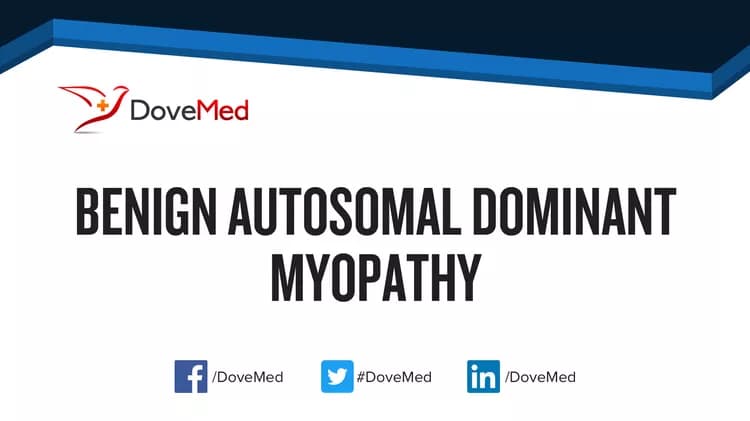What are the other Names for this Condition? (Also known as/Synonyms)
- Benign Myopathy with Autosomal Dominant Inheritance
- Bethlem Myopathy 1
What is Benign Autosomal Dominant Myopathy? (Definition/Background Information)
- Benign Autosomal Dominant Myopathy, also known as Bethlem Myopathy, is a benign autosomal dominant form of slowly progressive muscular dystrophy
- To date, fewer than 100 cases have been reported in the literature, thus illustrating its rarity
- The clinical features do not differ markedly from those of other mild forms of progressive muscular dystrophy with the exception of finger contractures, which are sometimes suggestive of the diagnosis
- Mutations in one of the three subunits of collagen VI are responsible for the disease
- Treatment remains purely supportive
(Source: Bethlem Myopathy; Orphanet, National Institute of Health and Medical Research (INSERM), Paris.)
Who gets Benign Autosomal Dominant Myopathy? (Age and Sex Distribution)
- Benign Autosomal Dominant Myopathy is a rare congenital disorder, with fewer than 100 cases being described in the medical literature
- The disorder is known to occur at a prevalence rate of less than 1:1000,000
- The presentation of symptoms may occur in infancy or during childhood
- Both males and females may be affected
What are the Risk Factors for Benign Autosomal Dominant Myopathy? (Predisposing Factors)
- A positive family history may be an important risk factor, since Benign Autosomal Dominant Myopathy can be inherited
- Currently, no other risk factors have been clearly identified for the disorder
It is important to note that having a risk factor does not mean that one will get the condition. A risk factor increases one’s chances of getting a condition compared to an individual without the risk factors. Some risk factors are more important than others.
Also, not having a risk factor does not mean that an individual will not get the condition. It is always important to discuss the effect of risk factors with your healthcare provider.
What are the Causes of Benign Autosomal Dominant Myopathy? (Etiology)
- Benign Autosomal Dominant Myopathy is caused by mutation(s) in one of the three subunits of collagen VI, namely COL6A1, COL6A2, and COL6A3
- The disorder is inherited in an autosomal dominant manner
Autosomal dominant: Autosomal dominant conditions are traits or disorders that are present when only one copy of the mutation is inherited on a non-sex chromosome. In these types of conditions, the individual has one normal copy and one mutant copy of the gene. The abnormal gene dominates, masking the effects of the correctly function gene. If an individual has an autosomal dominant condition, the chance of passing the abnormal gene on to their offspring is 50%. Children, who do not inherit the abnormal gene, will not develop the condition or pass it on to their offspring.
What are the Signs and Symptoms of Benign Autosomal Dominant Myopathy?
The signs and symptoms of Benign Autosomal Dominant Myopathy may include the following:
- Moderate muscle weakness
- Tightening of muscles
- Muscle stiffness
- Joint stiffness (involving the neck, finger, wrist, elbow, and ankle joints)
How is Benign Autosomal Dominant Myopathy Diagnosed?
Benign Autosomal Dominant Myopathy is diagnosed on the basis of the following information:
- Complete physical examination
- Thorough medical history evaluation
- Assessment of signs and symptoms
- Laboratory tests
- Imaging studies
- Biopsy studies, followed by immunofluorescence labeling of cultured cells from affected individual to check for collagen 6
Many clinical conditions may have similar signs and symptoms. Your healthcare provider may perform additional tests to rule out other clinical conditions to arrive at a definitive diagnosis.
What are the possible Complications of Benign Autosomal Dominant Myopathy?
The complications of Benign Autosomal Dominant Myopathy may include:
- Increasing stiffness of muscles and joints with time
- Difficulty with movement, walking
Complications may occur with or without treatment, and in some cases, due to treatment also.
How is Benign Autosomal Dominant Myopathy Treated?
There is no cure for Benign Autosomal Dominant Myopathy, since it is a genetic condition. The treatment is usually given to manage the signs and symptoms and any complication that may develop.
How can Benign Autosomal Dominant Myopathy be Prevented?
Currently, Benign Autosomal Dominant Myopathy may not be preventable, since it is a genetic disorder.
- Genetic testing of the expecting parents (and related family members) and prenatal diagnosis (molecular testing of the fetus during pregnancy) may help in understanding the risks better during pregnancy
- If there is a family history of the condition, then genetic counseling will help assess risks, before planning for a child
- Active research is currently being performed to explore the possibilities for treatment and prevention of inherited and acquired genetic disorders
Regular medical screening at periodic intervals with tests and physical examinations are recommended.
What is the Prognosis of Benign Autosomal Dominant Myopathy? (Outcomes/Resolutions)
- The prognosis of Benign Autosomal Dominant Myopathy is dependent upon the severity of the signs and symptoms and associated complications, if any
- Individuals with mild conditions have better prognosis than those with severe symptoms and complications
- Typically, the prognosis may be assessed on a case-by-case basis
Additional and Relevant Useful Information for Benign Autosomal Dominant Myopathy:
The following DoveMed website link is a useful resource for additional information:
Related Articles
Test Your Knowledge
Asked by users
Related Centers
Related Specialties
Related Physicians
Related Procedures
Related Resources
Join DoveHubs
and connect with fellow professionals


0 Comments
Please log in to post a comment.